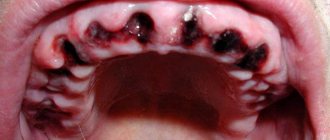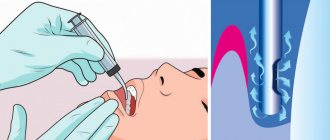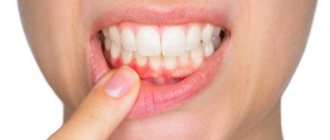Indications for use
The ointment copes well with inflammatory processes and draws out pus. The main indication for use is the formation of purulent wounds.
The product treats wounds and boils. Also used for severe forms of hemorrhoids, herpes, purulent skin rashes. Can be used as local therapy for inflamed lymph nodes.
The patient is prescribed anti-allergy medications, vitamins, and calcium gluconate. In advanced cases, an operation is performed to open the pustules and carry out antibacterial treatment.
Some doctors prescribe ointment for a runny nose and sinusitis, when the problems are caused by a microbial infection.
The ointment showed excellent results in the treatment of purulent formations in the oral cavity. Levomekol will help fight stomatitis, periodontal disease, and inflammatory reactions. Also used as a pain reliever when removing or inserting teeth.
The patient himself causes the “dry socket” effect to appear.
A dry socket will definitely manifest itself if the patient does not adhere to the dentist’s recommendations after tooth extraction and willfully allows such actions as
:
- thinking that he is making his condition easier by rinsing blood clots out of the tooth socket too often and intensively;
- thinking that his tongue has healing properties, he constantly “checks” with his tongue the surrounding tissue of the pit and the pit itself inside;
- Having convinced himself that he should drink in a thin stream, he drinks everything through a straw or sips all drinks from a spoon with his lips, thereby creating a vacuum effect in the mouth;
- not giving a damn about the doctor’s strict recommendations, he ignores the restrictions, and at least a little, at least a little, engages in heavy physical labor or sports during the rehabilitation period after removal (oh, like, look how cool I am!).
Dry socket syndrome in wisdom teeth
The concept of dry socket syndrome refers to the wisdom tooth. In the case of a wisdom tooth, this is practically alveolitis. It can also occur in this area, especially in the area of the lower wisdom teeth due to the fact that as a result of swallowing, as a result of opening the mouth, the muscles tense, which aggravate the occurrence of alveolitis.
What can dry socket syndrome lead to and what to do?
Dry socket syndrome can lead to very severe pain that radiates to the temple and ear. This is a very great torment: a person cannot, even if he is not sensitive, he cannot tolerate it, he will definitely take painkillers 4-5 or 6 tablets. And as a result of this, he will still go to the dentist. This dry socket condition will not go away on its own. It can only get worse - up to inflammation of the jaw, alveolitis. There can be very disastrous consequences.
Instructions for use
The ointment can be used by adults and children from 3 years of age. The product is applied to the open wound using sterile cotton wool and secured with a bandage. You can inject ointment into a purulent wound using a syringe.
The dressing must be done every day until the pus is completely removed from the wound.
If the affected surface is large enough, then the permissible dose per day should not be more than 3 g.
The ointment should be used within 4 days from the moment of infection. In severe conditions, the course of treatment can be extended to a week. With prolonged use, osmotic shock may occur in healthy cells.
For sinusitis, ear inflammation and runny nose
If you have a runny nose, soak a cotton pad with ointment and insert it into your nasal passages. If possible, keep for 3-4 hours. For ear inflammation and sinusitis, you need to make a tourniquet out of gauze, soak it in ointment and insert it into the ear for 8-12 hours.
In dentistry
When a tooth is removed and the oral mucosa is damaged, you need to rub the ointment with light circular movements into the problem areas. You can use the ointment no more than 3 times a day.
For hemorrhoids
Before applying the product, you need to rinse the anal area with water at room temperature and dry with a towel. After this, you can apply the ointment.
For burns
Levomekol has proven itself well for burns of varying severity. In severe cases, the ointment is only an aid and cannot replace general treatment. Before applying the ointment, the affected area of the body should be washed and covered with a napkin treated with ointment. The bandage needs to be changed 4 times a day.
For acne
Acne appears as a result of bacterial and infectious infection. Dermatologists recommend applying a thin layer of ointment to small rashes and leaving for 3-4 hours. Afterwards, rinse with water. In this way, acne can be treated for no longer than 12-14 days. In case of isolated rashes, it is better to cover the treated area with a gauze bandage.
What is dry socket?
During the operation to remove a tooth, the mucous membrane is damaged.
After a tooth is removed, in the space where the tooth itself was located, after some bleeding, a fairly dense blood clot forms, which promotes healing of the wound. This is how physiology works, showing its protective functions and promoting the speedy independent healing of the wound.
WHAT WELL:
some unpleasant symptoms, such as slight bleeding, pain and a feeling of heat in the socket after 3-10 days, after restoration of the upper tissues completely disappear.
WHAT IS WRONG:
if the blood clot has completely disintegrated or has been washed out, then in this case the hole will become so-called. dry, exposing bone and nerves. Therefore, the appearance of a dry socket can be accompanied by severe pain. The first five days after tooth extraction are the most important, and it is during this time that the risk of dry socket is greatest.
special instructions
It is better to avoid simultaneous use with drugs that inhibit hematopoiesis.
After using the product, the reactive susceptibility of the skin may increase, which is why hypersensitive reactions may then appear at the time of using the ointment.
If you need to use the ointment for longer than a month, you will need to take a peripheral blood test.
The drug does not in any way affect the ability to drive a vehicle or operate other dangerous machinery.
There are no cases of negative effects when taken in parallel with other drugs.
If the ointment gets on the mucous membranes, you need to rinse them well with water. If the ointment gets inside, you need to rinse the stomach with activated charcoal.
Healing of the extracted tooth socket
METROGYL DENTA® is used for complex treatment and prevention of post-extraction alveolitis (inflammation of the socket after tooth extraction). The use of the drug helps eliminate inflammation by suppressing the activity of pathogens inhabiting the oral cavity. To prevent post-extraction alveolitis, the tooth socket after extraction is treated with METROGIL DENTA® gel and then the drug is applied for 7-10 days 2-3 times a day. METROGYL DENTA® has a good safety profile and is suitable for the treatment of periodontal diseases and mucous membranes of the cavity, starting from the age of 18.
Up to contents
The information in this article is for reference only and does not replace professional advice from a doctor. To make a diagnosis and prescribe treatment, consult a qualified specialist.
Tips for caring for a healing socket
The success of wound healing depends on two people: the doctor and the patient. If the doctor has already done everything in his power, it is up to the patient. The latter needs to be taken into account and carefully follow the recommendations and prescriptions. These may include the following:
- Leave in place and do not remove the embedded turunda (bandage). It protects against infection and promotes healing, and is often covered with medication. Usually the turunda is removed after 30 minutes, but in some cases (with complex wisdom tooth removal) it will have to be kept for 5-15 days.
- Follow a rinsing schedule. A specialist can prohibit them or recommend them. This point is very important. The best option is to take the medicinal solution into your mouth and simply tilt your head towards the healing hole.
After a tooth is removed, a blood clot should form in the wound. You shouldn’t disturb him for no reason, no matter how much you want to. It protects the wound from infections. Therefore, you do not need to rinse your mouth more often than the specialist advised, or do it too intensively. Water can wash out the clot, and then healing will be delayed.
If bleeding occurs, you can take clean gauze, roll it up in several layers, place it on the hole, bite and hold for up to 45 minutes. If bleeding continues for a long time, you will have to go to the doctor again.
After the anesthesia wears off, pain may occur. There is no point in enduring pain. It is worth using the painkiller recommended by the doctor. Also, do not ignore the recommendation to take medications. The experience of a specialist will tell you what a particular patient needs.
In a normal case, the hole heals and stops bothering you after about a week. If there are complications, the process takes longer and causes inconvenience. If the drug course is completed, no complications are observed and the hole has healed, you can simply stop thinking about it - it does not need attention. The only point that concerns the gums in general is that it is better to handle toothpicks more carefully and not to get into a recently healed area.
Medicinal properties
Levomekol ointment for tooth extraction is effective due to its anti-inflammatory and antibacterial properties. Levomycetin in the drug helps prevent gum infection and inflammation after tooth extraction. Prevents the proliferation of streptococci and staphylococci.
Methyluracil promotes gum healing after tooth extraction and tissue scarring. The formative composition represented by polyethylene glycols is able to enhance medicinal effectiveness and absorb the ichor that is released at the site of the former tooth.
Contraindications and adverse reactions
It is not recommended to use the medicine for a long time, since it can provoke an allergy to the drug in the future due to sensitization of the mucous membranes. It is recommended to continue treatment for no longer than four days.
Side effects may include:
- allergic reactions;
- skin rashes;
- swelling, hyperemia;
- hives.
Detection of any side effects is an indication to discontinue the drug and consult a dentist. It is not recommended to use the ointment on your own after dental procedures - you should first clarify whether the use of Levomekol is advisable in an individual case.
How to treat alveolitis after tooth extraction
It happens that the empty socket becomes inflamed after tooth extraction , the temperature rises, and an unpleasant odor is heard from the mouth. And all this “happiness” lasts up to two weeks. If these symptoms are familiar, then most likely you are dealing with alveolitis.
Alveolitis is inflamed socket walls with reduced protective properties, which can occur as a result of alcohol intake, or a traumatic tooth extraction operation, or improper oral care, or if the integrity of a blood clot is violated by the patient. Also, one of the reasons may be an inflammatory process as a result of the development of an infection that is located in the socket of a diseased tooth, especially if it is removed due to exacerbation of periodontitis, or complications of periodontitis. Against this background, a general decline in immunity, characterized by the patient’s age, and previous illnesses can play a negative role.
Sometimes alveolitis after tooth extraction can lead to suppuration of the affected area, and at the same time to necrosis of the affected tissues of the oral cavity. Signs of alveolitis after tooth extraction, in the opinion of the vast majority, are very harmless. Something like “it hurts and it goes away.” This is not true, in its neglected form, this disease can deprive teeth in the literal sense of the word.
Alveolitis after tooth extraction symptoms
The disease is characterized by the presence of pain in the socket of the extracted tooth, which only increases during meals, but never disappears. The rest of his health, including body temperature, is completely normal. The hole itself may be filled with a blood clot, there may also be food particles and saliva secretions there. The mucous membrane of the gum itself becomes inflamed red, and touching it causes discomfort.
If at this stage of development you do not seek help from a specialist, then in the future, the pain will move to the ear, temple, and to the part of the head where the affected area is located. At the same time, the state of health will no longer be characterized as normal, the body temperature rises, eating due to pain becomes more difficult from time to time, and the hole itself will be covered with a gray coating with a pronounced unpleasant odor. The lymph nodes under the jaw swell, and also cause pain when moving the jaw, and swelling forms on the face. Also, alveolitis itself can cause a number of other, no less unpleasant diseases.
Treatment of alveolitis after tooth extraction
To cure this disease, you should remember one important rule - no amateur activities. Only a doctor can provide truly effective assistance, and no one else. Folk remedies will remove the symptoms, but will not make the disease go away.
The doctor himself will begin the treatment directly - under local anesthesia, the treatment of the hole will begin. With the help of a syringe and an antiseptic, everything unnecessary is washed out of it - saliva, food, clots, pus. Next, with a surgical spoon they remove everything that could not be removed. After this, the hole is again treated with an antiseptic, dried, and closed with a gauze strip soaked in an antiseptic and anesthetic. If alveolitis is in the initial stage, then after treatment the pain does not return, and the inflammatory areas resolve within a couple of days. The main thing is not to let pus appear in the hole; in this case, even with active treatment, the pain will not go away.










